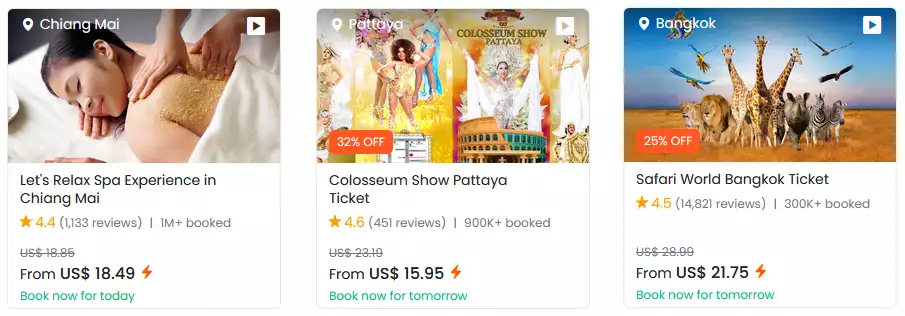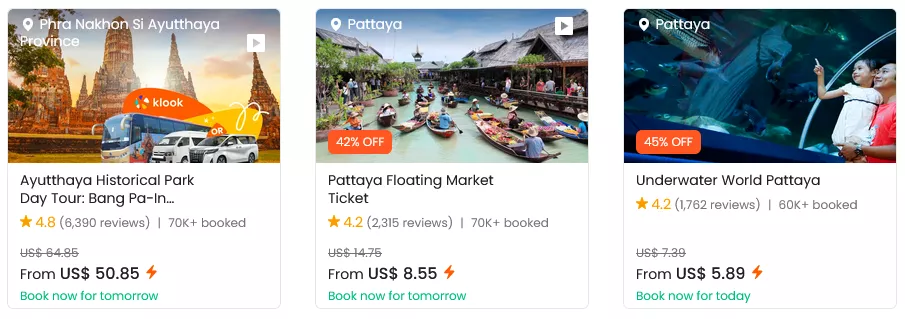
📍 Travel Planning
✈️ Getting to Thailand
🏡 Where to Stay
🥗 Local Cuisine / Food
🎭 Culture + Customs
🎒 What to Bring
🚍 Transport / Tickets
🧗♂️ Activities in Thailand
🎉 Markets + Festivals
⚠️ What to watch out
💸 Money in Thailand
☀️ Weather in Thailand
❓ FAQ + Travel Tips
Quick answer: Solo travel in Thailand is incredibly rewarding — the country is accessible, vibrant, and offers a huge variety of experiences. From the buzzing streets of Bangkok to the peaceful mountains of the north and the dreamy islands in the south, you can tailor your trip exactly how you like. Thailand’s transport is well developed (buses, trains, scooters), the food scene is unforgettable, and the locals are welcoming, making it a great place to explore on your own.
At a glance:
- 🕌 Bangkok: Urban energy, markets, temples, and street food.
- 🌿 Northern Thailand: Trekking, hill tribe villages, and peaceful mountain towns.
- 🏝️ Islands & Beaches: Island‑hopping to places like Koh Tao, Krabi, or Koh Lanta for chill or adventure.
- 🍲 Thai Food: From pad thai and tom yum to regional specialties — markets are your best friend.
- 🚍 Getting Around: Use buses, trains, tuk‑tuks, or rent a scooter for flexibility.
- 📅 Best Time to Visit: November–February for cooler weather; monsoon season (Jul–Oct) on the islands.
- 🛡️ Safety: Generally safe, but use standard precautions and stay aware of your surroundings.
- 🥾 Solo-Friendly Activities: Join cooking classes, meditation retreats, or day treks to meet fellow travelers.
Last updated in November 2025.
Solo Traveling in Thailand – Explore On Your Own.
-
- Embark on a journey to Thailand without a travel agency, to a place where the blue sea meets lush green jungle, and the scent of exotic spices accompanies every step. Thailand, a land known not only for its white sandy beaches and majestic temples but also for its rich history, diverse cuisine, and incredibly friendly locals. If you crave an authentic experience and don’t want to be tied to a rigid travel agency itinerary, venture into the secrets of the Kingdom of Siam on your own.
- Thailand, the heart of Southeast Asia, beckons travelers from all corners of the world with its diverse possibilities. However, to truly explore every corner of this fascinating destination, there’s nothing better than embarking on an adventure on your own. Traveling without a travel agency in Thailand offers the freedom to explore, immerse yourself in the culture, and build stories not overshadowed by tourist groups.
Thailand Offers a Unique Adventure Without a Travel Agency.
-
- Forget about pre-planned tours and set out on a journey without limitations. In this guide, read key advice and tips on planning an individual trip to Thailand to experience the best this country has to offer. From accommodation to food, local customs to adventures on the open sea – get ready for experiences that will stay in your memory like the sun on the Andaman beaches. Travel to Thailand, where every moment is a colorful adventure, and every corner hides secrets waiting to be uncovered.
- Thailand is one of the most visited and popular countries in Southeast Asia. It offers plenty of historical attractions and authentic cuisine. Every year, millions of tourists come here for a relaxing vacation, and many travelers explore this country on their own without a travel agency. Exploring Thailand on your own is not too challenging if you plan at least a rough itinerary and read the most important useful information. Thailand is relatively safe and is very popular even among low-cost travelers.
BOOK a TOUR / ACTIVITY in Thailand ➜
🚶 Solo Travel in Thailand – Planning and Exploring:
1. Trip Planning: Open the Travel Map.
When planning your trip to Thailand, open the map as a gateway to endless possibilities that this fascinating country offers. Begin by exploring key destinations, such as the pulsating Bangkok, where modernity meets traditional Thai culture. In Chiang Mai in the north, experience peaceful oases and a historical atmosphere, while on the southern beaches in Krabi and Phuket, you’ll find white sand and azure seas.
-
- As you study the map, don’t forget to consider lesser-known but incredibly charming areas. Nature reserves, remote villages, and hidden beaches can add unique nuances to your itinerary. Explore the map of national parks, such as Erawan or Khao Sok, where you’ll find breathtaking scenery and rich fauna.
- Next, consider the climate and seasons. Thailand has three main climate periods – dry, rainy, and cool. Pay attention to this information in your planning to ensure a pleasant trip.
- Once you have a rough outline of your trip, start looking for accommodation. The choice ranges from five-star hotels to traditional guesthouses or homestays, depending on your preferences. Thailand offers practically all options. When searching online, it’s advisable to read reviews from other travelers and consider factors such as public transport availability and proximity to main attractions.
- Opening the map and sketching out a rough travel plan will provide you with a broader perspective on the diverse palette that Thailand offers, allowing you to create a great plan tailored to your interests and preferences. It’s challenging to determine how long to stay in Thailand, but most solo travelers plan for at least 1 month.
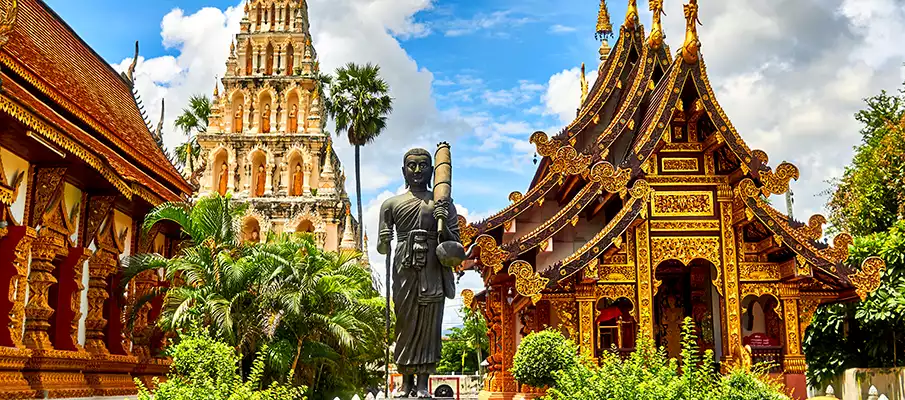
2. How to get and travel to Thailand?
Thailand, known for its stunning landscapes, vibrant culture, and delicious cuisine, is a popular destination that attracts millions of visitors each year. If you’re eager to explore the Land of Smiles, here’s a quick guide on how to get there.
-
- 1. Flights: The most common and convenient way to reach Thailand is by air. Suvarnabhumi Airport in Bangkok is the country’s main international gateway, welcoming flights from major cities worldwide. Numerous airlines offer direct flights, providing options for various budgets and travel preferences. Do some research to find the best deals and consider booking in advance for the most cost-effective options.
- 2. Visa Requirements: Before you embark on your journey, make sure to check the visa requirements for your nationality. Many visitors are eligible for a visa-free entry for a specified duration, while others may need to obtain a visa in advance. Ensure that your passport is valid for at least six months beyond your intended departure date.
- 3. Land Entry: If you’re in a neighboring country, such as Cambodia or Laos, and prefer overland travel, you can cross into Thailand by bus, train, or even by hiring a car. Thailand shares land borders with several countries, and border crossings are generally well-maintained and accessible.
- 4. Sea Travel: Thailand is surrounded by the Andaman Sea and the Gulf of Thailand, making sea travel another option. Phuket, Koh Samui, and other coastal areas have international ports that welcome cruise ships and ferries. Consider exploring these options for a more scenic and leisurely journey.
- 5. Local Transportation: Once you arrive in Thailand, the country’s efficient transportation system makes it easy to explore. Domestic flights, trains, buses, and taxis are readily available to take you to various destinations within the country.
Conclusion: Whether you choose to fly in, cross overland, or sail into its waters, getting to Thailand is a journey filled with excitement and anticipation. Plan ahead, stay informed, and get ready to embark on an unforgettable adventure in the Land of Smiles.

3. Accommodation: From Luxury to Budget Options.
When it comes to accommodation in Thailand, you have a wide range of options reflecting the diversity of this beautiful country. Various well-known resorts offer luxurious and modern resorts and hotels, budget-friendly hostels, guesthouses, or even private apartments. The options are truly numerous. A fascinating experience can be staying in various resorts and bungalows in nature, such as in mountainous areas.
-
- Luxury Resorts: Thailand is home to some of the world’s most luxurious resorts. If you enjoy unparalleled comfort, top-notch services, and stunning views, you’ll love staying in a five-star beach resort or amidst tropical gardens. These luxury hotels often offer wellness and spa services, gastronomic experiences, and top-notch facilities.
- Traditional Guesthouses: For those seeking a more authentic experience, traditional Thai guesthouses are the right choice. Located in local communities or historic quarters, these accommodations provide an opportunity to experience the Thai lifestyle. They are usually simpler but fully open to the community, allowing you to interact with locals and get a glimpse into their daily lives. Prices are generally low.
- Boutique Hotels: Thailand also offers a wide range of boutique hotels that combine luxury with a personal modern or retro style. These smaller, independent hotels are often creatively interesting and focus on a personal experience. You can expect unique furniture, original artworks, and intense guest care.
- Staying with Locals: When exploring less touristy areas, you may also consider staying with local residents. Airbnb offers the option to rent a room or apartment from local families, allowing you to immerse yourself in the culture and gain an authentic insight into life in Thailand. However, you can find many similar accommodations or private apartments in larger cities or beach destinations on Agoda’s platform.
Consider your preferences, plans, and budget when choosing accommodation. Whether you opt for a luxury beach resort or a traditional guesthouse in the heart of the city, accommodation in Thailand will contribute to the overall impression of your unforgettable adventure. It’s also good to consider whether the accommodation offers its own cuisine and dining options.
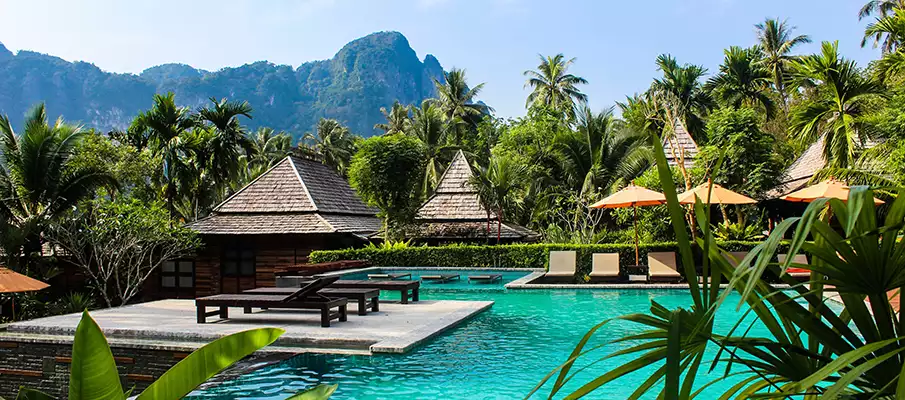
4. Immerse Yourself in Thai Cuisine and Delicacies.
One of the strongest magnets that will draw you into the heart of Thai culture is the diverse and captivating Thai cuisine. Embark on an unforgettable culinary expedition where each bite reveals the secrets of a place where culinary arts are an integral part of everyday life. When traveling in Thailand without a travel agency, you’ll have the chance to visit various markets, street food stalls, and even more secluded restaurants where crowds of tourists usually don’t go.
-
- Traditional Delicacies: Open your taste buds to traditional Thai dishes, such as the famous Pad Thai, where delicate noodles, shrimp, and nuts dance in a unique symphony of flavors. Enjoy the aromas of Tom Yum soup, which combines spicy, sweet, and sour tones. Or let yourself be enchanted by the experience of one of the favorite curries, where the combination with exotic herbs creates an explosion of flavors.
- Thai Markets and Stalls: Explore local markets where your taste buds will awaken to the freshness and authenticity. Try dishes from street stalls, where local chefs create delicious meals right in front of you. Don’t forget to taste som tam (green papaya salad) or khao pad (rice mixed with meat and vegetables).
- Regional Specialties: Thai cuisine varies regionally, so take the time to explore local specialties. In northern Thailand, indulge in khao soi, a sauce with coconut milk and noodles, while in the south, savor the flavors of excellent seafood and exotic sauces.
- Culinary Courses: For those eager to deepen their knowledge of Thai cuisine, culinary courses are available. Engage in the preparation of traditional dishes under the guidance of local chefs and take away not only taste experiences but also the ability to reproduce Thai delicacies at home.
- Floating Markets: Thai floating markets are a colorful kaleidoscope where boats offer fresh fruit, traditional dishes, and craft products. Explore the waterways where local traders and chefs come together to create a unique space for discovering authentic Thai atmosphere and gastronomy.
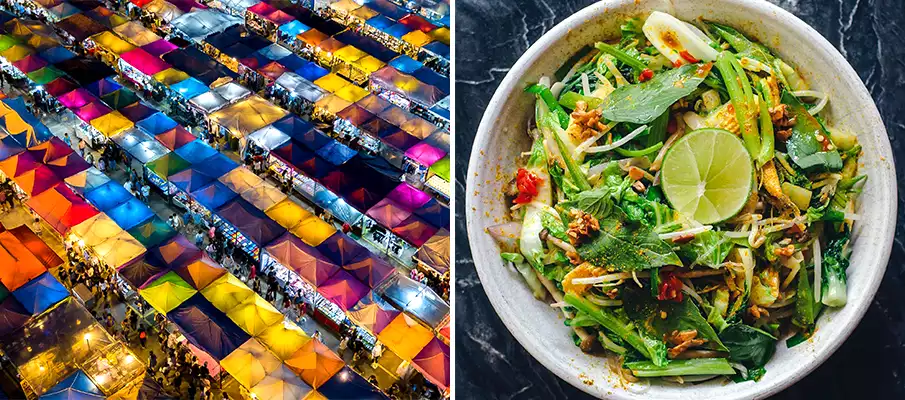
5. Culture and Customs: Respect Local Traditions
Deepen your adventure in Thailand by immersing yourself in its rich culture and maintaining respect for local customs. Enter a world where every smile has its own story, and where tradition plays a crucial role in everyday life.
-
- Visit Temples: Temples are the heart of Thai culture, and exploring these sacred places will provide you with a deeper insight into the spiritual life of the country. When entering a temple, dress modestly (covering shoulders and knees), remove your shoes, follow instructions, and maintain a peaceful atmosphere.
- Sawasdee Ka and Krub: Greet locals with respect using the Thai words „Sawasdee Ka“ for women and „Sawasdee Krub“ for men. These courteous words add authenticity to your interaction with locals and demonstrate your respectful approach.
- Avoid Forbidden Gestures: Refrain from using your feet to touch your head or other people, as feet are considered the lowest part of the body and the head the highest. Also, avoid pointing at people or sacred objects with your feet, as it is considered disrespectful.
- Etiquette in Eating: Follow certain customs while dining. Never give or take food with your left hand, which is considered less hygienic in traditional Thai culture. It is also a local custom to serve and receive food with both hands.
- Respect in Quiet Areas: In quiet and religious areas, maintain silence and respect. Limit loud conversations and phone calls to avoid disturbing places with a sacred atmosphere. Never undress to nudity at religious and sacred sites.
Respecting local traditions is not only a fundamental rule of etiquette but also a key to enriching your Thai adventure. At the same time, this respect will bring you sincere smiles and friendly interactions with local residents who will appreciate your respect for their culture.
BOOK a TOUR / ACTIVITY in Thailand ➜

6. What to Bring and What Not to Bring to Thailand:
When packing for your adventure in Thailand, it’s crucial to consider not only the climate but also the culture and activities you plan to engage in. Prepare for all aspects of your Thai adventure with a focus on comfort, safety, and local etiquette. It’s also good to know that you can purchase almost everything in cities in Thailand; however, the situation may be different in remote areas or villages. Packing according to the needs and specifics of the destination will allow you to explore Thailand comfortably and efficiently with minimal travel stress.
-
- Clothing: Thai climate can be variable, so it’s ideal to bring lightweight and breathable clothing. Shorts, light dresses, and short-sleeved shirts are suitable for daytime activities. For temple visits, bring long pants and a scarf or shawl to cover your shoulders.
- Footwear: Comfortable footwear is crucial, especially if you plan on walking, hiking, or exploring cities. Comfortable sandals or lightweight sneakers are an excellent choice. Keep in mind that you’ll often need to remove your shoes when visiting temples. For mountainous areas, bring comfortable lightweight trekking shoes.
- Swimwear: If you’re heading to the beaches or planning to swim in the hotel pool, don’t forget your swimwear. They are welcome not only on the beaches but also in some hotel wellness facilities.
- Sun Protection: The sun in Thailand can be very strong, so pack high-quality sunscreen with a high SPF. A hat and sunglasses are also useful for additional protection from the sun’s rays. Again, these items can be purchased in Thailand.
- Practical Accessories: Also, bring a portable charger, an adapter for electronics or charging (check the adapters and sockets), a first aid kit with necessary medications or remedies for common issues, and antiseptic wipes. Packing an umbrella or a waterproof jacket can be useful, especially during the rainy season.
What to Bring to Thailand: Basic toiletries, a passport with a validity of more than 6 months, copies of important documents, local currency, and photocopies of prescription medications are essential. If you are traveling to Thailand for up to 30 days for tourism, you don’t need a visa. Alternatively, check the details about other visas to Thailand on the Ministry of Foreign Affairs portal. You can also obtain electronic visa to Thailand online.
What Not to Bring to Thailand: Unnecessarily heavy clothing or too much jewelry can unnecessarily burden your luggage space. Try to minimize large electronic devices and evenly distribute essential items in your bags. Consider that you’ll be transporting yourself, and if you want to save energy, take as little as possible.
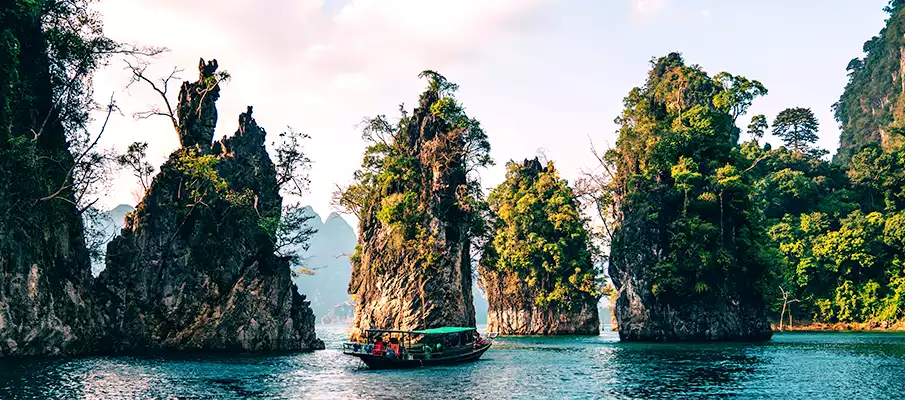
7. Transportation Options in Thailand for Travelers:
Thailand offers diverse transportation options that allow travelers to comfortably explore every corner of this fascinating country. From modern means to traditional modes, the choice of transportation in Thailand can impact not only your comfort but also the overall travel experience.
-
- 1. Domestic Flights: For quick connections between distant destinations, domestic flights are the best choice. Airlines like Thai Airways or AirAsia offer frequent connections between major cities and popular destinations. Short flights make it easy to cover large distances in a short time.
- 2. Train Travel: Thailand’s railway system provides efficient connections between cities and regions. Major trains, such as those between Bangkok and Chiang Mai, are comfortable and offer great views of the landscape. Local trains are an excellent choice for traveling between smaller towns and discovering local life. Check out the railway map of Thailand.
- 3. Bus Transportation: For travel over short and medium distances, buses are a common choice. There are both air-conditioned long-distance routes and cheaper options with local buses. The Mochit 2 – Chatuchak bus station in Bangkok (Mochit 2 – Chatuchak) serves as a central station for most long-distance connections.
- 4. Boat / Ferry Transportation: Thanks to extensive waterways, boats are a popular mode of transportation to Thailand’s popular islands. Floating markets, river taxis, and boat trips between islands are characteristic experiences. Transportation to islands is often done by ferries and various speedboats, offering relaxing travel across turquoise waters.
- 5. Motorcycles and Scooters: For flexibility and an adventurous experience, you can rent a motorcycle or scooter. Especially in urban areas, scooters are a popular mode of transportation, but always wear a protective helmet and be cautious as traffic can sometimes be busy. You must have a valid international driver’s license to ride motorcycles in the country.
- 6. Tuk-tuks and Songthaews: Tuk-tuks are a well-known icon of low-cost Thai transportation. These small motorized carts are suitable for short distances within the city, but the price usually needs to be negotiated in advance. Songthaews, shared transportation in trucks, are popular for traveling in smaller groups.
- You can book tickets / flights in Thailand online on Baolau ➜ or 12go.asia ➜
- On these relevant search engines, you can search for and purchase tickets for buses, trains, boats, flights, taxis…
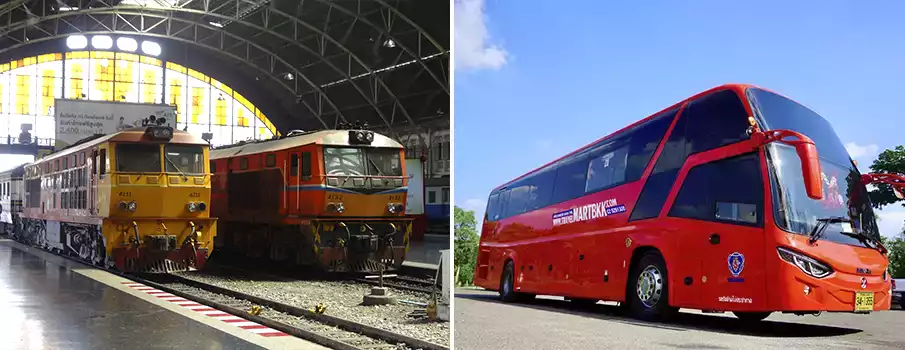
8. Tailored Activities: Diving, Trekking, and Yoga.
Thailand is not just a land of beautiful beaches and exotic cuisine, it is also a paradise for those who crave active and adventurous travel. From the underwater world to mountain peaks and serene beach yoga, Thailand offers a wide range of activities that cater to every adventurer.
-
- Diving in the Andaman Sea: The Thai coast along the Andaman Sea ranks among the world’s best diving locations. Areas like Krabi and Phuket take you to the underwater kingdom, where you can explore coral reefs, marine life, and fascinating shipwrecks. For diving enthusiasts, there are courses for beginners and advanced divers.
- Trekking in National Parks: For nature lovers and adventure seekers, Thai national parks offer amazing trekking trails. Try trekking in Khao Sok National Park, where you can venture into the heart of the rainforest and spend the night in floating huts. Chiang Mai in northern Thailand is also an excellent starting point for mountain trekking and meeting local ethnic tribes.
- Beach Yoga and Wellness on Islands: If you seek harmony of body and mind, Thai islands provide an ideal environment for beach yoga and wellness. Many resorts offer yoga classes by the sea with the sound of ocean waves and the scent of exotic flowers. Spa centers provide traditional Thai massages and wellness procedures for overall relaxation.
- Kayaking in Phang Nga Bay: Explore the unique rock formations in Phang Nga Bay by kayak. This beautiful area, known for its towering limestone cliffs, hidden caves, and turquoise waters, offers a unique view of the Thai landscape. You can rent a kayak and discover the secrets of this picturesque bay.
- Cultural Excursions and Educational Courses: For those who want to immerse themselves in Thai culture, there are many options for cultural excursions and educational courses, including cooking classes. Visit markets where you can learn to cook traditional Thai dishes or participate in courses on traditional Thai arts, such as dance or carving.
- Rock Climbing in Krabi: Krabi, known for its towering limestone cliffs, is an internationally acclaimed haven for rock climbers. Railay Beach, near Krabi, is one of the best places for rock climbing with a view of the Andaman Sea. Most routes are suitable for climbers of various levels, from beginners to advanced. The beach is accessible only by boat.

9. Local Markets and Celebrations: Join the Local Life.
Thai markets are the pulsating hearts of local culture and unique events for travelers who yearn to experience the authenticity of Thai life. Join the joys of local festivities and explore traditional markets that offer not only delightful treats but also a glimpse into everyday life.
-
- Traditional Markets: Stroll through local markets, where you can best acquaint yourself with Thai cuisine and culinary delights. Markets are where the scents of Thai cuisine and vibrant activity intertwine. Chiang Mai Night Bazaar or Chatuchak Weekend Market in Bangkok are just some of the unforgettable markets that open a window into daily life. Most major cities usually have some interesting street markets.
- Street Festivals: Thai festivals are not only expressions of joy and festivity but also a wonderful opportunity to engage in local traditions. Villages and large cities celebrate traditions like Songkran, the Thai New Year known for its cheerful water battles. Loy Krathong, the festival of floating lanterns, and Yi Peng, the flying lantern festival, are other unforgettable events that bring the community and foreigners together in a unique experience.
- Art and Craft Markets: For those who love arts and crafts, Thailand offers markets specializing in local handicrafts and art workshops. Explore markets in Chiang Mai that offer traditional Thai crafts or head to the town of Pai, where you can find markets with original art and design.
- Get Involved: Don’t let the language barrier deter you. Local residents are often open and friendly, and if you make an effort to communicate, you can gain great tips and stories from those who know their area best.
Joining local markets and festivals in Thailand means immersing yourself in the authentic atmosphere, where every experience, scent, and flavor present a delightful view of Thai life. Street markets, street food, markets, floating markets, and festive and entertaining festivals are, of course, part of Thailand’s cultural richness.

10. Things to Watch Out for Solo Travelers in Thailand:
Traveling in Thailand without a travel agency can bring unique and authentic experiences, but it’s important to be cautious and respect local norms and rules. When traveling independently in Thailand, pay attention to several key factors to ensure a safe and enjoyable adventure.
-
- 1. Healthcare: Before your trip, verify that you have valid vaccinations and find out what healthcare you might need in case of problems. Always carry a first aid kit with necessary medications to be prepared for potential illnesses or injuries. Maintain proper hydration and avoid low-quality food.
- 2. Travel Insurance: It is absolutely essential to take out quality travel insurance that will protect you from unforeseen situations such as baggage loss, health issues, or even trip cancellations. Carefully study the insurance terms and choose a plan that covers your individual needs.
- 3. Safety Measures: Thailand is generally considered a safe destination, but, like in any country, always keep your eyes open. Keep valuables in secure and lockable places, avoid secluded and poorly lit areas in the evening, and refrain from unnecessarily exposing your valuable electronics in public.
- 4. Respect Local Customs and Traditions: Observe and respect local customs and traditions. Enter temples with humility and knowledge of proper behavior. Respect the local culture and avoid expressions that could be considered offensive.
- 5. Avoid Excessive Bargaining: Avoid excessive haggling over prices, especially in markets. Local traders deserve a fair price for their goods. When negotiating, maintain respect and clarify what is acceptable for both parties. If you disagree, politely decline and walk away.
- 6. Guard Against Scams: Be cautious when it comes to scams. Don’t be lured by overly advantageous offers or cheap trips from unknown individuals. Prioritize your safety and choose trustworthy sources for your travel plans.
- 7. Protection Against Crime: Pay attention to your surroundings, especially in large cities. Keep an eye on your belongings and avoid street hazards. Always verify the safety measures at your accommodation.
- 8. Book Tickets Online: To avoid fraudulent and unreliable transportation providers, search for and book tickets and flights easily online in advance. Use a reliable platform, such as 12go.asia, where you can find almost all tickets for buses, trains, boats, and flights.

11. Money and Currency in Thailand: How Much to Bring.
Proper handling of money is a key element for comfortable and hassle-free travel in Thailand without a travel agency. Although most tourist destinations accept credit cards, having adequate cash for small purchases, markets, and outdoor stalls is still essential. It’s not easy to estimate how much one month of travel will cost, as everyone has different preferences and requirements. When planning your financial strategy for traveling in Thailand, take into account several factors:
-
- 1. Currency and ATMs: The Thai currency is the Thai Baht (THB). Most ATMs in Thailand accept international credit and debit cards. Check before your trip if your card type is accepted in the country and inform your bank about your travel plans to use your card safely abroad.
- 2. Currency Exchange and Hotels: Currency exchange services are common in tourist areas and most major cities. However, keep in mind that exchange offices in resorts or at airports may offer less favorable exchange rates than those in cities. Hotels often provide currency exchange, but rates may also be less advantageous.
- 3. Cashless Payments: Credit cards are widely accepted in hotels, restaurants, and shops, especially in larger cities and tourist areas. However, some rural and less tourist-oriented places may prefer cash.
- 4. Cash for Local Experiences: Many markets, small shops, and local stalls only accept cash. For an authentic experience and local purchases, it’s good to have enough cash. Bargaining is often possible when buying at markets, and having cash can be advantageous.
- 5. How Much to Bring: The amount of money to bring depends on your plans and preferences. It’s advisable to have some cash for the beginning, but you don’t need to carry large sums. Relying on ATMs is a convenient way to get money as needed and also allows you to take advantage of better exchange rates.
- 6. Secure Your Finances: Consider securing your financial resources. Keep copies of credit cards and important documents. Avoid carrying large amounts of money in public and use security measures, such as a safe in your accommodation.
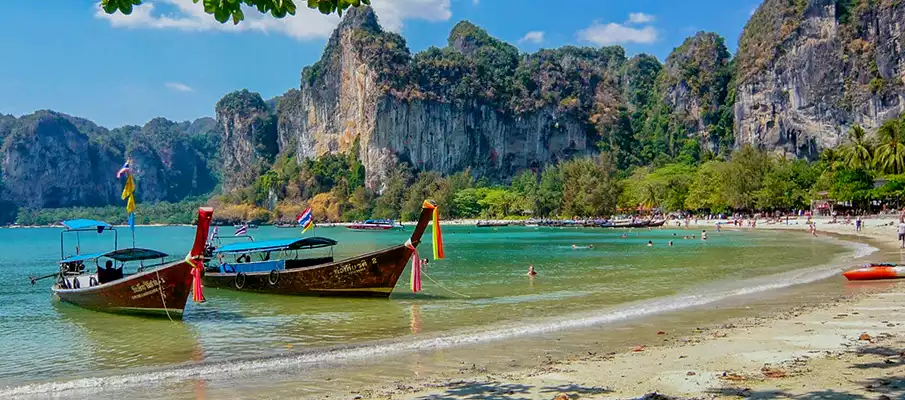
12. Weather and Climate in Thailand – What to Expect?
In Thailand, the climate is divided into three main seasons based on the monsoon periods, which influence the weather in different parts of the country. Generally, the best time to visit Thailand depends on specific preferences and planned activities, but the dry season is a good time for visit.
Dry Season (November – February):
-
- The dry season is often considered the best time to visit Thailand. During these months, the weather is pleasant and dry, facilitating easier exploration and outdoor activities. Temperatures range within a comfortable bracket, whether you are in the northern mountains, on the southern beaches, or in central Bangkok.
Hot Season (March – June):
-
- March to June brings the hot season when temperatures can reach high levels. This period is popular among tourists who prefer sunny days on the beach. However, keep in mind that it can get really hot, especially in central and northern parts of Thailand.
Rainy Season (July – October):
-
- The rainy season brings monsoon rains, which can be intense, especially on the southern islands. While rain can be refreshing, many tourists prefer to avoid this time if they plan to visit beach destinations. However, in the northern parts, including Chiang Mai, the weather may still be acceptable.
Overall, there is no universally ideal time to visit Thailand as each season has its advantages. Travelers seeking serene beaches and sunny days may consider the dry season. Those who prefer fewer crowds might think about visiting during the rainy season when nature thrives, and the country showcases its most vibrant face. It is always advisable to monitor the current weather forecast and specific conditions for particular regions before planning a trip.

❓ Questions + Tips – Solo Travel in Thailand:
1. Where to Buy Tickets + Flights for Transportation in Thailand?
2. What Is the Best Mode of Transportation in Thailand?
-
- The optimal mode of transportation in Thailand depends on your preferences and plans. Domestic flights are a quick way to cover longer distances. Buses and trains can be an economical choice for local transport within cities and between them. Tuk-tuks, mototaxis, or local taxis are suitable for shorter distances.
3. Do I Need a Visa for Thailand, and How Can I Obtain It?
-
- Most tourists, do not need a visa for Thailand for tourist stays up to 30 days. Upon arrival at international airports, you will receive a tourist visa. Different types of visas may be required for longer stays (3-6 months) or different purposes of the visit.
4. What Are the Best Places for Accommodation Outside Tourist Centers?
-
- To experience authentic Thai life, it is recommended to seek accommodation outside the main tourist centers. Cities like Chiang Mai, Chiang Rai, or Krabi offer a quieter and more authentic atmosphere with an opportunity to explore the local culture.
5. What Is the Safety Situation for Travelers in Thailand?
-
- Thailand is generally considered a safe destination for tourists. However, it is always important to observe common safety precautions. Keep your eyes open in crowded places, take care of your valuables, and respect local customs.
6. What Is the Local Cuisine, and What Should I Try?
-
- Thai cuisine is diverse and full of flavors. You can taste traditional dishes such as Pad Thai, Tom Yum, Som Tum, or various meat dishes served at street stalls. Don’t hesitate to explore new flavors and experiment with local specialties.
7. What Is Suitable Attire in Thailand?
-
- Due to the warm and humid climate, it is advisable to wear light and airy clothing. Always carry a scarf or shorts for temple visits, where covering shoulders and knees is required. If you are heading to mountainous areas in the north, you may want to pack a light windbreaker.
8. How to Avoid Seasonal Rains and Monsoons?
-
- The best period to visit Thailand is from November to February when the weather is dry and pleasant. The monsoon season, from June to October, can bring heavy rains. It is recommended to plan your visit outside of these months.
9. Where to Find the Best Beaches Outside Tourist Areas?
10. What Are the Recommended Vaccinations for Traveling to Thailand?
-
- Before traveling to Thailand, it is recommended to get vaccinated against hepatitis A and B, typhoid, and other insect-borne diseases. Additionally, using insect repellent for protection and adhering to basic hygiene measures is important.
11. What Are the Safety Recommendations for Swimming in the Sea in Thailand?
-
- When swimming in the sea, it is important to follow warnings and instructions from local authorities regarding sea currents and safety. In areas with coral reefs, wearing appropriate footwear and avoiding contact with corals to prevent injuries is advisable.
12. What are the basic rules for safety when traveling in Thailand?
-
- Although Thailand is generally safe, it is important to observe basic precautions. Keep an eye on your belongings in crowded places, respect local customs and rules, and don’t forget safety instructions in case of natural disasters.
13. When is the best time to visit Thailand and why?
-
- The best time to visit Thailand is during the dry season from November to March. This period offers pleasant temperatures and minimal rainfall, making it ideal for exploring the country.
14. What are the recommended activities for solo travel in Thailand?
-
- Recommended activities include visiting temples and palaces, exploring local cuisine at markets, relaxing on beaches, and participating in traditional festivals. Excursions to national parks and underwater adventures are also popular.
15. Where to Go from Bangkok and How?
-
- From Bangkok, you can head to the city of Ayutthaya, Pattaya, or to the south of Thailand to Phuket or Krabi. You can also take a train from Bangkok to the popular Chiang Mai in the north.
BOOK a TOUR / ACTIVITY in Thailand ➜
| Solo Travel in Thailand – Useful Information: | Descriptions |
|---|---|
| 1. Informal Accommodation: | Embark on a journey of discovery in Thailand by choosing informal accommodations such as cozy guesthouses, vibrant hostels, or traditional bungalows. These options not only offer budget-friendly stays but also immerse you in the heart of local culture. Experience the warmth of Thai hospitality, engage in cultural exchanges, and gain a deeper understanding of the community. |
| 2. Local Currency and Financial Tips: | Navigate the financial landscape of Thailand by familiarizing yourself with the Thai Baht, the official currency. When venturing independently, ensure you carry ample cash, as some places may not accept cards. Seek out reputable currency exchange services for favorable rates. Be mindful of banking limitations in certain areas, and plan your financial transactions accordingly. |
| 3. Local Cuisine and Safe Eating: | Indulge your taste buds in the culinary delights of Thailand while traveling independently. Explore local markets, savor street food, and dive into authentic dishes. Exercise caution when choosing street vendors to ensure food safety. Thai cuisine is a rich tapestry of flavors; try iconic dishes like pad Thai, som tam (green papaya salad), and mango sticky rice for an unforgettable gastronomic adventure. |
| 4. Local Transportation and Tuk-Tuks: | Experience the vibrant pulse of Thailand’s local transportation by hopping on tuk-tuks, moto-taxis, or public buses when traveling independently. Tuk-tuks, in particular, are an iconic mode of transport. Negotiate fares in advance or opt for metered rides to avoid misunderstandings. For inter-city travel, consider buses and trains, providing reliable and cost-effective options for exploration. |
| 5. Cultural Respect and Attire: | Immerse yourself in Thai culture by respecting local customs and adhering to appropriate attire, particularly when visiting temples and sacred sites. Dress modestly, covering shoulders and knees as a sign of respect. Carry a lightweight scarf or dress in your backpack for easy adjustments. This cultural sensitivity enhances your travel experience and fosters a harmonious connection with the community. |
| 6. Safety and Caution: | Thailand is generally considered safe for travelers, but exercising caution is paramount. Safeguard your belongings, especially in crowded areas and tourist hotspots. Stay vigilant in unfamiliar surroundings, particularly at night. Be cautious about your personal safety, avoid poorly lit areas, and stay informed about local conditions by following advice from authorities. |
| 7. Local Festivals and Traditions: | Enhance your Thailand adventure by aligning your visit with local festivals and traditions. Experience the exuberance of Songkran, the Thai New Year, marked by nationwide water fights. During Loy Krathong, witness rivers adorned with thousands of lit lanterns. Participating in these events provides a deep cultural immersion and unforgettable insights into Thai traditions. |
| 8. Natural Beauties and Beaches: | Discover the natural wonders of Thailand by exploring its breathtaking beaches, especially along the southern coast. Destinations like Phi Phi and Railay boast pristine white sands and turquoise waters. Venture beyond the beaches to explore national parks and mountainous regions. Embark on jungle treks, marvel at cascading waterfalls, or unwind in natural hot springs for a diverse and enriching natural experience. |
| 9. Language Barrier and Basic Thai: | While English is commonly spoken in tourist areas, learning basic Thai phrases can deepen your connection with locals. Demonstrate respect by attempting simple greetings and expressing gratitude in the local language. Basic phrases such as greetings, thank you, and essential communication expressions enrich your travel experience and foster positive interactions with the Thai community. |
| 10. Off-the-Beaten-Path Activities: | Diverge from mainstream tourist routes and uncover the authentic essence of Thailand by exploring lesser-known areas. Visit remote villages, meander through local markets, and discover hidden landmarks to gain profound insights into local life and culture. These off-the-beaten-path activities offer a unique and personal perspective, creating memories untethered by conventional tourist destinations. |
Interesting Thinsg in Vietnam|Khao Lak – Guide|Hua Hin – Guide|Koh Tao Island – Guide|Koh Phangan – Guide|K.Samui – Guide|Cat Ba Island
